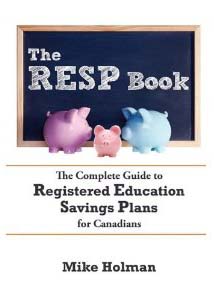
If you’ve been reading our blog over the past few months, you will notice we talk a lot about education savings and Registered Education Savings Plans (RESPs).
Saving for a child’s education is an important goal for many families. But it is also a confusing and often difficult task. Parents are often struggling to balance daily expenses, a desire to buy a home or to pay down an existing mortgage, all while also needing to plan for their own retirement. Education savings is just one more thing on the financial “to-do” list.
RESPs are a fantastic tool which allow for tax-free growth of your education savings, and give access to government grants to top up your savings. But with all the rules and exceptions and options, parents often don’t know how to get started – or chose a plan early on, and later realize that it does not work for them, and it is too late to get out without penalties.
Parents (and uncles and aunts, grandparents, family friends, etc.) I am happy to tell you about a fantastic new resource: Mike Holman’s The RESP Book. Mike, a long-time personal finance blogger (First at Four Pillars, which later became the Money Smarts Blog) has written an easy to read, easy to follow guide to Registered Education Savings Plans. He will help you to understand how the accounts work, how to get one started, what kind of RESP account to set up and what kind of investments to buy. He addresses all the relevant topics: RESP grant eligibility, types of grants, Canada Learning Bonds, contribution rules, withdrawal rules, how to avoid penalties, and (I was so happy to see this!) basic investing information.
I spend my days educating Nova Scotians about investing. I have heard the complaints, and sometimes the horror stories of those who have gotten into investment products they do not understand. I have helped individuals navigate the often unreadable fine-print of account contracts and websites. Here, finally, is a comprehensive resource written in plain-language, full of easy to understand examples, to help parents and family members feel confident they are investing their education savings safely, and building a nest egg for their child.
The RESP Book is available from Amazon.ca, but one lucky reader will receive a free copy from Before You Invest and the Nova Scotia Securities Commission. Simply leave a comment below with your RESP question, frustration or success. On Monday, November 8, I will draw one name from all commenters and send that person a free copy. Good luck.
Related posts:
- Get up to $2000 for your child’s education savings We’ve talked a lot this month about the value of...
- Book Review: What Investors Really Want by Meir Statman If I had any say in the matter, books like...
- Paying for your child’s education Well, it’s that time of year again. University classes started...
- Book Review: The Frugalista Files by Natalie P. McNeal Fru·gal·is·ta [froo-guh-lee-stuh] -noun 1. A person who lives within her...
- Canada Education Savings Grants As we have been discussing all month, education is getting...
Share & Bookmark This Story!
 Bookmark on Delicious
Bookmark on Delicious  StumbleUpon
StumbleUpon  Google Bookmarks
Google Bookmarks Tip'd
Tip'd 



{ 11 comments… read them below or add one }
Thanks a lot for the great review!
My question is why can’t we self-direct our RESPs? Do you know the history of that decision?
If I don’t win the book, I will pick it up and review it for my blog:
http://moneyandmeforcanadians.blogspot.com/
This is very timely for us Natalie. We are looking at starting an RESP for our two girls, albeit very late as they are both teens now.
My question is, is it true that you can contribute both last year’s and this year’s allowable limit at the same time? ie. deposit for both years right now?
Thanks in advance
[My financial institution is] as clueless about RESPs as they are about their own e-accounts! I’d feel much better if I had this book in hand!
Laura Thomas: what gives you the idea you can’t self-direct your RESP? My discount brokerage offers RESP accounts, and I’m sure other (all?) brokerages do too! Your bank probably doesn’t and if they don’t have a brokerage division they may be misleading you to keep your money – or worse: your rep is misleading you to keep your money under his management (which directly affects his salary).
I’m getting mixed messages on the advantages and disadvantages of family vs individual plans. Does it really matter which?
Allow me to quote Mike on this one:
“The two account types are similar, because the rules allow you to transfer money between any type of account.” He goes on to point out that while there is no real advantage to one strategy over the other, having one single family account means only one account fee.
Rob – you can carry over contribution room from one year to the next, but the rules are complex – I may need to dedicate a whole post to the topic. You can only contribute one year’s unused contribution room at a time. So though you may have 15 years to make up for, this year you could make a contribution for 2010 and 2009. Next year, for 2011 and 2008, and etc.
It is somewhat more complicated for older children as well. Annual contribution room is now $2500, but before 2007 was $2000. Also, there are special grant and contribution rules for 16 and 17 year olds. This link might help: http://www.canlearn.ca/eng/saving/cesg/src.shtml
Laura – self-directed RESPs are available at most financial institutions. Do a quick google search on the term, and hopefully you will find info on what your preferred financial institution provides.
I have a 6-week old and want to understand the ins and outs of RESPs as part of our new financial reality. Thanks for reviewing this book!
Thanks for the review.
I want to make the most of the CESG available to me, but with my second child on the way how am I supposed to contribute $5000/year???
That is not an easy question to answer, Big E. Everyone’s budget is different, and $5,000 a year is just not possible for everyone. If you want to try to make it work, perhaps set a budget including stricter savings goals, or talk to a financial adviser for advice. Good luck.